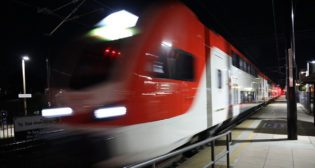
Amtrak Issues FY20 Sustainability Report
Written by Marybeth Luczak, Executive Editor
In FY 2020, Amtrak advanced climate resilience research and response, which included developing its first solar-power purchase agreement contract and tools to incorporate climate risks into capital planning, for instance.
Amtrak has published a sustainability report for FY 2020, highlighting projects across its regions and operations as well as measured progress against its annual and long-term goals.
Although ridership fell in 2020 due to the pandemic, Amtrak said it advanced climate resilience research and response, which included developing its first solar-power purchase agreement contract and tools to incorporate climate risks into capital planning, as well as initiating internal climate roundtables across various departments.
The report (download below) features such projects as:

• Moynihan Train Hall: Opened for service Jan. 1, 2021, sustainability was a focal point for the project, which restored and upgraded a historic building for modern transit center use. The main concourse offers natural light and spacious rooms with 92-foot ceilings and overhead parabolic skylights, which were created by reusing the building’s steel trusses. Train information displays use LED lights, and escalators are equipped with smart features, including heaters, to ensure reliability during cold weather, and with a “sleep mode” to save energy and increase durability, Amtrak noted. The design team is currently pursuing Leadership in Energy and Environmental Design (LEED) Transit certification for Moynihan Train Hall’s sustainable design and construction, according to Amtrak.
• Climate Resilience Planning: “Recognizing that our changing climate is adversely affecting our operations, Amtrak has been investigating climate risks,” the railroad reported. “Based on recent weather data and revenue analysis, since 2006, Amtrak lost more than $127M in revenue due to named storms and severe weather disruptions, with a projected loss (based on historic costs) of an additional $220M by 2030. Based on predicted storm surge and flood maps, if we continue business as usual, we are exposed to increasing operational, financial and reputational risks.”
In FY 2020, Amtrak started outlining the vision for a Climate Resilience Strategic Plan, pulling together resiliency work already under way and setting out a plan and goals for the future. The main objectives: to better understand current business practices, available data, vulnerabilities, and climate risks. “As we identify goals and objectives for ensuring resiliency in our supply chain, operations and infrastructure, we will establish priorities and metrics to track progress,” Amtrak reported. “The strategic plan will outline where and how we can best absorb external disturbances, maintain the core mission and functions of Amtrak, and safely recover to previous or improved conditions. What we are undertaking requires involvement across all departments and collaboration with state and federal partners, host railroads, climate experts, scientists, transit agencies and other stakeholders.” The first phase of the plan will focus on the Northeast Corridor.

• Food Finders: In early 2020, Amtrak prepared for the uptick in spring-break travelers by stocking packaged goods and perishable items. But as the pandemic impacted Amtrak operations, that food was at risk of becoming waste. Amtrak’s Los Angeles team contacted Food Finders, a nonprofit, to collect those items, as well as linens and towels, and distribute them, free of charge, to local food pantries, shelters and community centers. The railroad also teamed with Central Union Mission in Washington, D.C.; Northwest Harvest in Seattle, Wash.; King Majesty Ministries in Chicago, Ill.; Operation Dignity Inc. in Oakland, Calif.; St. Jude’s Community Center in New Orleans, La.; Brookline Food Co-Op in Boston, Mass.; City Harvest in New York; and Curley’s House Food Bank in Miami, Fla.
“By investing in innovative equipment and new technologies, protecting vital rail infrastructure from climate change, reducing greenhouse gas emissions, and expanding access to new communities, we can work together to create a future where intercity rail is operated on clean energy,” Amtrak CEO Bill Flynn said. “Investment decisions made today position us to achieve these goals. These visions and our strong sustainability story continue to evolve and grow every year.”

Download the FY20 Sustainability Report:



